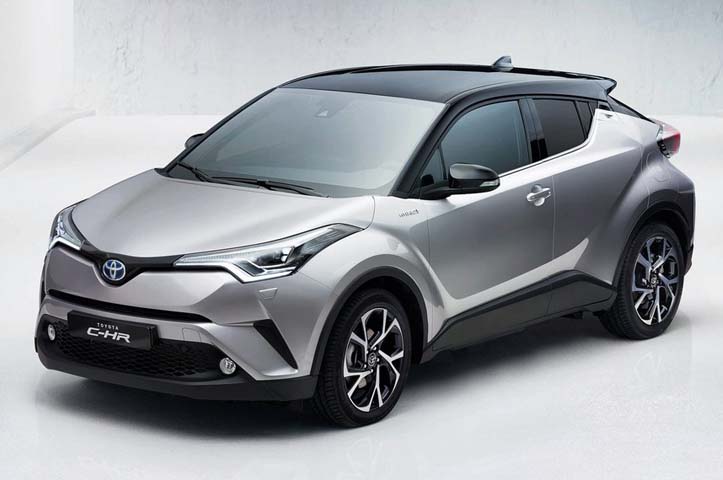
The head-turning C-HR is an advantageous expansion to the savagely battled minimal hybrid class. It’s not exactly as functional as its standard adversaries, but rather it compensates for this with its particular styling, classy cabin, grown-up driving elements and good value for money. Be that as it may, unless you truly need to save money on tax, we’d avoid the somewhat baffling hybrid for the sweet and willing 1.2-litre model.
Toyota has arrived fairly late to the swarmed conservative hybrid gathering, however with its challenging Toyota C-HR, it wants to be noticed.
Made to go up against models, for example, the Nissan Qashqai and SEAT Ateca, the newcomer is one of the main Toyotas planned only because of European purchasers. The Japanese firm has gone striking, blending car, concept car and 4×4 fan plan signs to head-turning impact.
Supervisors at the brand are unmistakably certain of achievement, guaranteeing that the C-HR will find 100,000 homes crosswise over Europe throughout the following year.
Stroll up to the C-HR – which remains for Coupe High Rider– and you’ll be shocked by how huge it is. The outline is intensely in view of the C-HR Idea that made its introduction at the 2014 Paris Motor Show, and the challenging blend of points and high-riding SUV position masks the shockingly cumbersome measurements.
Initially, the auto appears to be identical size as a Nissan Juke; however it really fills a comparative impression to a bigger Qashqai. Like it or abhor it, the C-HR unquestionably pulls in consideration.
A wraparound dash with unmistakable blue embed and expansive tablet-style infotainment screen overwhelm the cabin, while repeated diamond patterns in the overhead courtesy lights and headlining add interest.
However the most amazing thing about the inside is the quality. First rate materials are utilized all through, and there’s better than average space. The thick C-columns mean back seat tenants feel stitched in, yet there’s amazing head and legroom.
In advance, the high-set seats and substantial windscreen give a decent perspective of the road.
Underpinning the car is the same Toyota New Global Architecture that also forms the basis of the impressive new Prius, which means the C-HR handles with composure. Engineers have invested a ton of energy adjusting the car for European streets, and it appears.
The steering is normally weighted and dynamic, there’s solid grasp, and body roll is very much contained. Profound potholes can send a shiver through the car, yet for whatever remain of the time the C-HR rides well.
Control originates from the same 120bhp 1.8-litre petrol-electric hybrid unit and CVT transmission as the Prius, yet sadly the set-up isn’t also incorporated here. Where the Prius consolidates CVT gearbox and electric engine to convey smooth and easy increasing speed, the C-HR appears to depend vigorously on its inward burning motor. Indeed, even tender uses of the throttle send the motor’s revs taking off.
More awful still, the four-cylinder unit experiences a coarse and intrusive note. There’s a Sport setting that hones the throttle reaction, yet this lone empowers the 1.8-litre unit to work harder, sooner. It’s not even as though the excited soundtrack brings about avid execution, in light of the fact that the C-HR needs a relaxed 11.0 seconds to cover 0-62mph.
The new Toyota is additionally accessible with an 114bhp 1.2-litre turbo petrol and six-speed manual, and a brief drive in this affirmed it was a sweeter blend. Still, there’s no contending with hybrid effectiveness; diesel rivals won’t coordinate the guaranteed 74.3mpg and 87kg/km CO2 discharges. In addition, with tender utilize you’ll even get the C-HR to drive in zero-emissions electric mode for short separations.
At launch there will be three trim levels: Icon, Excel and Dynamic. Costs go from £20,995 for the entry level 1.2 to a powerful £27,995 for the lead flagship Dynamic Hybrid.
Every one of the 1.2-litre autos get a chpice of six-speed manual or CVT boxes, in addition to this unit has the alternative of four-wheel drive. There’s additionally a lot of unit, with all autos including atmosphere and cruise control, in addition to Toyota’s Security Sense set-up that brings adaptive cruise and autonomous emergency braking.
There’s no diesel and Toyota expects the C-HR Hybrid to be the top-offering powertrain. The CO2 is a noteworthy 86g/km. In any case, we say keep away from it, unless you’re restricted to a city. Since the C-HR is too useful for that. The hybrid’s droney motor, its noisy relationship amongst rpm and speed, and its conflicting brakes are all set to doom it.